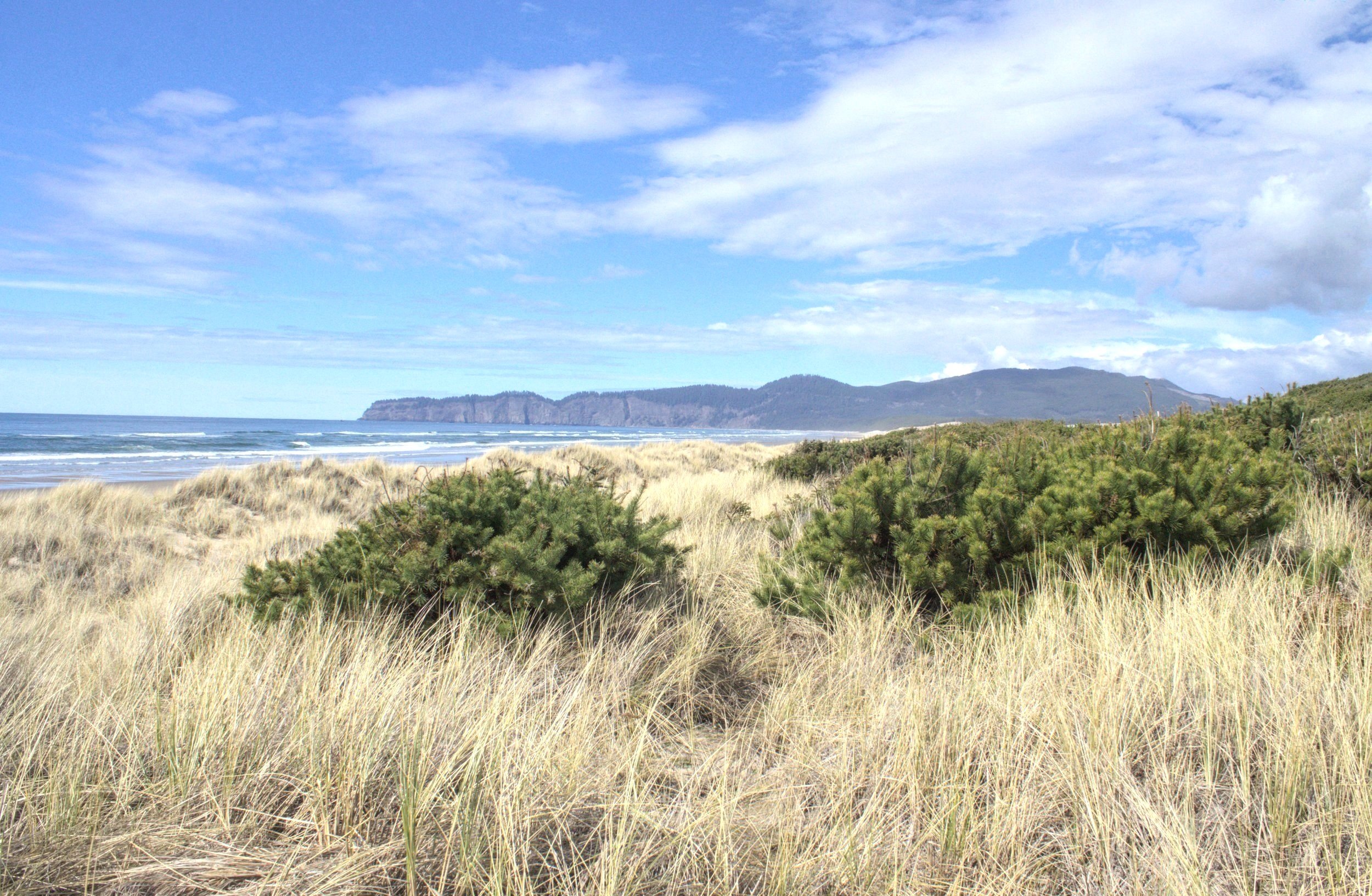Birds, Trails, and Beaches at Sitka Sedge State Natural Area
The secluded hiking trails through Sitka Sedge State Natural Area will take you through three different worlds over a surprisingly short distance. You’ll begin in a tidal marshland, pass through a coastal forest, and then arrive at miles of sandy beaches flanked by dramatic headlands. Despite being just down the road from some of the Oregon Coast’s most popular destinations, Sitka Sedge remains a tranquil destination for birdwatchers and nature lovers. Next time you’re looking for a quieter alternative to Cape Kiwanda or Cape Lookout, try hiking through the many worlds of Sitka Sedge.
Know before you go
Parking is free at Sitka Sedge State Natural Area. No pass or permit is needed.
Leashed dogs are welcome in the park.
There are restrooms and picnic tables next to the parking area.
Sitka Sedge State Natural Area is a protected habitat. Please do not remove plants or animals. Leave the clams for the birds.
There are two ways to reach the beach from the trailhead. The shortest way is a 1.5-mile out-and-back trail that leads straight there. You can also make a 3.5-mile lollipop loop, stopping at the beach about halfway through the loop portion. Look for a couple of viewpoints overlooking the wetlands along the loop trail.
The trails here are all family-friendly. The first 0.5 miles are doable with a stroller.
Most trail junctions in the park are marked with signs, although it is helpful to have an offline map. Look for a map of the park near the picnic area.
From March 15th - September 15th, a portion of the beach is closed to protect nesting snowy plovers. You can still hike on the loop trail and walk along the beach. Just make sure to avoid closed areas and keep your dog on a leash when nearby. Signs make it clear where you can go.
Consider bringing binoculars for a better look at the birds.
Buffleheads in the mudflats at Sitka Sedge Natural Area
Trail map sign near the picnic area
The Sitka Sedge Loop Trail
Distance: 3.5 miles
Elevation gain: 100 feet
Difficulty: Easy
Pass required: None
Dog friendly: Yes, leashed dogs are welcome on the trail.
ADA access: Some. The 0.5-mile gravel trail through the wetlands is wide, flat, and even. Once you reach the forest, the trail becomes narrower and more irregular. Accessible restrooms and picnic area.
Beltz Dike
Basic directions: From the trailhead, walk 0.5 miles along the Beltz Dike. At the end of the dike, you’ll reach a trail junction marked with a sign. Go right to do the loop portion of the trail counterclockwise. Or, go left to take the shortcut to the beach or do the loop clockwise. Look for beach access around halfway through the loop. After finishing the loop, return to the parking area via the Beltz Dike.
Tidal marshlands at Sitka Sedge
On the Sitka Sedge Loop Hike:
Look for the trailhead behind the picnic area near the parking lot. The hike begins on the Beltz Dike, a wide, flat gravel path flanked by wetlands. The dike forms a barrier that blocks salt water from the ocean reaching areas farther inland. The wetlands to the left of the dike are freshwater while those to the right are saltwater.
This 0.5-mile stretch of the hike is the best place to watch for birds in the surrounding marshes and mudflats. Several benches along the way provide good vantage points for those wanting to spend more time with the birds. I also spotted a couple of rabbits darting into the grasses along the trail here.
Great egret
At the end of the Beltz Dike, you’ll reach a trail junction that begins the loop portion of the hike. From here, the trail becomes narrower and more uneven. You’ll also leave the obstructed views of the wetlands behind and enter the forest.
You can go either direction at the trail junction to do the loop. Going right will take you counterclockwise around the north end of the loop first, called the Estuary View Loop. Going left will take you clockwise through the Kinnikinnik Woods Loop first. If you have time and energy, I’d recommend doing both portions of the loop. They lead you through a coastal forest with surprisingly varied vegetation over a fairly short distance.
Viewpoint on the Estuary View Loop
Taking a right at the first trail junction begins the Estuary View Loop portion of the hike. Follow the narrow path through a dense understory of salal and evergreen huckleberry bushes. The canopy of pines will become thicker as you go. After about 0.3 miles from the trail junction, you’ll reach a viewpoint overlooking the Sand Lake Estuary. Water levels in the estuary vary with the tides. Look to the west here for the first glimpse of the Pacific Ocean. If you bring binoculars, the estuary is also a great place to spot birds.
Heron in the Sand Lake Estuary
After admiring the viewpoint, continue on the trail through the forest, which will start feeling a lot more like the beach as the packed dirt trail transitions to sandy dunes. You’ll pass a trail junction at the northern end of the loop whose right fork is closed seasonally to protect nesting snowy plovers. Continue left here to avoid the closed area and reach the spur trail that will lead you to the beach.
A sandy trail means you’re almost to the beach
After about 0.4 miles from the Sand Lake Estuary Viewpoint, look for a trail junction and take a right to head to the beach. You’ll head up a short dune and follow the spur trail lined with beach grass. Look for the gigantic spire of Pacific City’s Haystack Rock to the south. To the north, you’ll see the basaltic headland of Cape Lookout jutting out into the ocean.
Haystack Rock on your way out to the beach
Beach access with Cape Lookout in the distance
Once you reach the beach, there is plenty to explore. A portion of the beach to the north is closed seasonally to protect snowy plover nests. The closed areas will be marked with signs. Even if you visit when part of the beach is closed, there are miles of sandy beaches to the south perfect for a stroll. You’ll see the sandstone headland of Cape Kiwanda and its nearby basalt sea stack, Haystack Rock to the south.
Looking south to Cape Kiwanda and Haystack Rock
Once you’re ready to leave the beach, return on the spur trail back over the dune until you are back at the trail junction. Take a right to continue around the loop hike. You’ll now be on the Kinnikinnik Woods Loop Trail.
Kinnikinnik Woods Loop Trail
The forest here on the southern half of the loop feels notably different than the one to the north. You’ll walk through an unusually dense canopy of pines along a trail lined with lichen and bright green moss. After 0.5 miles, you’ll reach a trail junction that provides a second opportunity for beach access. Keep left to stay on the loop trail. In another 0.25 miles, you’ll reach another trail junction. Consider taking a right here to explore the short (about 0.1 miles) spur out to Elk Knoll, a viewpoint with a bench overlooking the freshwater wetlands of Sitka Sedge.
Elk Knoll
After taking in the views from Elk Knoll, return to the loop trail. After 0.25 miles, you’ll pass a fork to the left that is the shortcut trail out to the beach. Keep right to stay on the loop trail. You’ll soon be back at the junction with the Beltz Dike. Here you’ll have another chance to see the birds before returning to the car.
Buffleheads at Sitka Sedge
Shorter hike options
Option 1: If you want to explore the wetlands and see the ocean but don’t want to commit to the full 3.5-mile hike, you can take the shortcut trail that leads directly to the beach for a 1.5-mile out-and-back hike. This trail bisects the loop, creating the shortest path to the ocean.
From the trailhead, take the 0.5-mile Beltz Dike Trail. Once you reach the forest, keep left at the first trail junction. After about 0.1 miles, you’ll reach another trail junction. Take a right and follow the trail about 0.25 miles straight out to the beach. You’ll pass a junction where the west end of the loop meets the shortcut trail. Go straight here. Signs at the trail junctions will help point the way.
Cape Lookout
Option 2: Use the shortcut trail to cut the full loop hike in half. Take the shortcut trail straight out to the beach like in Option 1, then return on either the Estuary View Loop or the Kinnikinnik Woods Loop.
Great egret and crows
Birds of Sitka Sedge
Sitka Sedge State Natural Area is one of the best places to look for birds on the Oregon Coast. The wetlands, tidal mudflats, forest, and coastline in the park provide an impressive variety of habitat types that attract birds of all sorts. Dozens of species visit Sitka Sedge, including seabirds, shorebirds, raptors, and songbirds. Look for Canada geese, mallards, egrets, herons, cormorants, buffleheads, gulls, bald eagles, and mergansers, among others. In particular, the dunes are an important nesting site for snowy plovers.
A protected snowy plover nesting site is in the dunes
Getting there
To reach Sitka Sedge State Natural Area from Portland, take Highway 26 West for about 20 miles, then make a slight left onto Highway 6 West toward Tillamook. Once you reach Tillamook, follow the signs for Highway 101 South. Take Highway 101 South for 9 miles, then turn right onto Sandlake Rd. After 4 miles, take a left to stay on Sandlake Rd. Stay on Sandlake Rd for 4.6 more miles. The parking area for Sitka Sedge State Natural Area will be on your right. The drive from Portland takes about 2 hours.
From Cape Kiwanda, drive north for 3.5 miles on McPhillips Dr, which becomes Sandlake Rd. Sitka Sedge State Natural Area is about 5 minutes away from the day-use area at Cape Kiwanda.
Explore Nearby
Munson Creek Falls
Try out the easy, 0.5-mile out-and-back trail to the spectacular 319-foot Munson Creek Falls. The trailhead is about 15 minutes away from Sitka Sedge State Natural Area.
Head 3.5 miles south down Sandlake Rd to explore Cape Kiwanda. From the southern end of the cape, you can walk up to the top of the headland and admire the cliffs from above. Be sure to look for the recently formed sinkhole.
Explore the north end of Cape Kiwanda at McPhillips Beach. This beach has an entrance about 2 miles from Sitka Sedge State Natural Area. It is quieter than the well-known headland of Cape Kiwanda and has some incredible rock formations if you walk or drive about a mile south on the beach.
Walk along the trails of the Nestucca sand spit at Bob Straub State Park.
Try out the famed Three Capes Scenic Drive, a 40-mile drive along a coastal byway that includes Cape Meares, Cape Lookout, and Cape Kiwanda.
Check out the sights around Oceanside, Oregon, including the intriguing tunnel that connects Oceanside Beach and Tunnel Beach, the twisting limbs of the Octopus Tree, and the striking waterfall of secluded Short Beach.
Visit the Neskowin Ghost Forest where the preserved stumps of 2,000-year-old Sitka Spruce trees appear at low tide.
Enjoy your trip to Sitka Sedge State Natural Area!
With love,
Emma
Looking for more to do at the Oregon Coast? From north to south, here are trip suggestions and travel tips for:
Also, check out my guides to the wildlife of the Oregon Coast and Oregon geology.
























